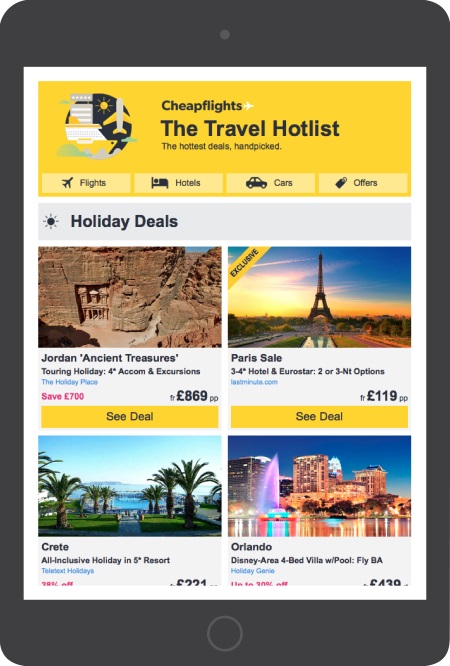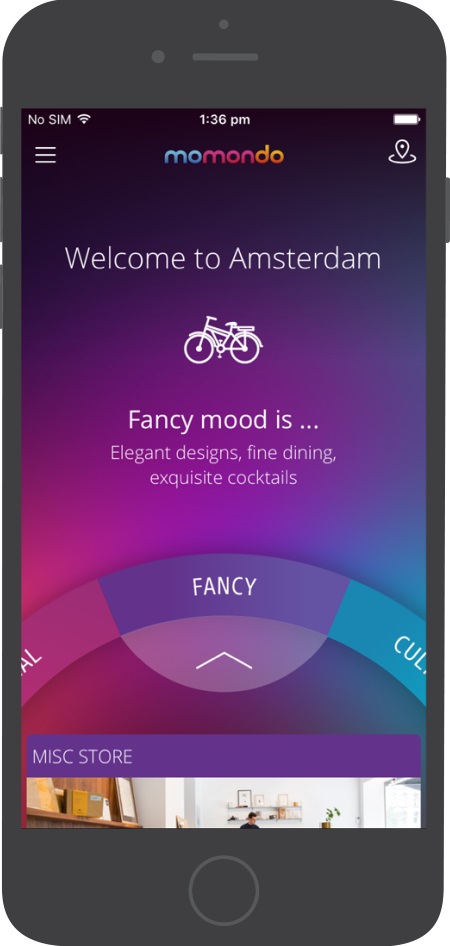
Personalisation and metasearch: in summary
By cameron in Uncategorized
Metasearch is an intuitive product that generates a foundation of trust through its inherent transparency. Personalisation, done sensitively, can build on this trust to inspire users and create loyalty.
NB This is a viewpoint by Hugo Burge, CEO of Momondo Group.
A series of articles published on Tnooz (links below) has explored how Momondo Group is approaching the challenge facing everyone the metasearch industry: how to shape that inbuilt integrity to build long term relationships with our users – characterised by repeat usage and advocacy – with a ‘personalised’ experience, not just a cold ‘best price’ guarantee.
Personalisation, as we see it, is an opportunity to side-step commoditisation in travel search: a way to take the relationship with a user beyond the transactional, become more meaningful and lay the foundation for long-term loyalty.
As travel tech brands feel their way in to a personalisation strategy, it tends to be ecommerce giants such as eBay and Amazon that are the best practice touchpoints with their ‘people who liked this also liked that’ and other ‘similar items’ features. But it’s a reductive approach that’s lot easier to do with books than with travel.
Personalisation in travel can be tricky. But therein lies an opportunity and although a whole host of variables come in to play when an individual is making their travel choices it doesn’t mean the solution needs to be complicated as well. Technology can aggregate data, but interpretation is still an issue, so often the solution is to empower the user with simple options and tools, taking more inspiration – perhaps – from the way Google works than retailers.
Another theme of our articles is how to make the experience personal by wrapping it in a sense of purpose, appealing to users’ emotional connection with, and reasons for, travelling. This stretches the typical definition of personalisation but is something that we feel strongly about at Momondo Group.
There are plenty of quick win tools that can help to create the impression of personalisation – but what is it that can truly create a positive user experience, engender a desire to repeat the experience and convert that user from ‘consumer’ to ‘advocate’?
For us, true personalisation describes how a brand builds the best possible (and most individual – or ‘human’) relationship with its consumers in a very real and instant way, helping to build an emotional connection and a long term relationship through the user experience, curated communications, content, product and brand values.
Personalisation is not solely about monetisation but it is also not mutually exclusive. Soft values of repeatability are every bit as important as immediate conversion rates and ROI.
What this series of articles has sought to show is that when combined sensitively and dovetailed to an engagement-driven retention and acquisition strategy that puts some degree of control in to the hands of the individual, monetisation and personalisation can work together to establish the bedrock of a loyalty that benefits both the user as well as the brand.
In doing so, we believe we establish a more ‘personal’, humanised, dynamic between our brands and our users.
We can distil our focus on personalisation in to three areas of focus:
Segmentation
Segmentation is an obvious place to start. It can offer quick wins but also has the greatest pitfalls, because of the nature of travel mindsets and hopelessly malfunctioning re-targetting strategies.
This area obviously has great potential and arguable the most complexity to resolve in order to get anything truly meaningful and powerful. However, it needn’t be ridiculously complex and requires a strong human input of common sense to keep it on-track.

Take the Cheapflights Newsletter product for example.
One of its key features is the ‘Travel Hotlist’; 20 deals relevant to the user’s chosen departure airport. The list is ordered according to the recipient’s preferences and historic click behaviour, and we can incorporate these preferences into the subject line of the email. This way we can make each email that goes out relevant to each recipient by providing them with prioritised deals and content at the top of the email, according to their behavioural data.
Of course, everything in this realm must be carefully managed, and delivered sensitively, so as to avoid us stepping over the line into intrusion, but this is a patient and incremental way of building trust with customers while improving personalisation, through our communications and our product together.
We are always working to put customer utility at the core of our personalisation strategies. It must always help the user make better decisions. If we achieve that, we believe that loyalty follows.
Customisation
Personalisation can be simple, by allowing users to decide what they want to experience. Alerts, filters, opting in to saving options or trips are all immediate ways to put control in users’ hands. This has proven enormously popular in search, is unobtrusive and a winner for loyalty.
A pragmatic but innovative approach to this taken by momondo is the Mood Wheel, a function which simply asks the user as to their intent in a very human and simple way – enabling them to customise their search according to how they’re feeling. In some ways this is simply user selection but the magic can be built by meshing this in with other background data, to try to get under the user’s skin, to tap into the expertise, knowledge and intuition that a travel agent might have.

There’s an irony in what might be dubbed a ‘Back to the Future’ trend here, where a return to a personal concierge vision, partly powered by humans, works with machines and the horsepower of AI/almost infinite memory and data.
It’s an exciting trajectory and something that is starting to become a reality through the emergence of bots and their ‘actionable’ conversations with users. Can a search engine know you better than your own mother and achieve the ‘segment of one’ Holy Grail? There is exciting potential for travel in this field, but whether consumers are ready to trust the solution is another thing.
Purpose
A strong sense of purpose defines how your product prioritises, sets the tone and the messages it embodies. For us, by opening our world, we hope our product makes things simple and uncluttered, while embodying the genuine excitement about the potential of travel to bring people together in an honest way.
In this regard we hope that our product speaks to users in a personal way and that robotic-mechanicalism or bogus adverts don’t undermine trust and belief in our products.
Of course, these three areas are most powerful when they overlap and reinforce each other.
It’s an exciting time in travel search and I would argue that personalisation is at the heart of a next wave of product innovation. A key message of these articles has been that a clear personalisation strategy is not just a nice-to-have, but a critical cornerstone for growth and longevity. The mobile experience is not dead, but the foundations for its demise are being forged. Text search, voice search and better mobile immersive UI are in the brewing.
Indeed Amazon Echo’s new screen interface is a game changer this nascent technology much needed in my view. Personalisation and effective recommendation will be increasingly important in order to compete as the UI of the internet becomes increasingly immersive.
We are committed to making travel search inspirational, combining the human touch, data and the power of computer intelligence. We believe this has great potential in building a loyal user base. Providing a personalised and relevant experience for customers has helped us to move our brands from just being the place to come for the cheapest flight from A to B, or to get a good deal on a hotel, to platforms which makes the world feel more open through smart travel search.
In the last article, we said that the ‘virtuous circle’ was complete when enough trust is earned among customers that they not only recommend your product to others but consent to share their data by signing up to a site and logging in when they visit. Each subsequent visit then provides ever-richer data to use for optimal personalisation.
However, it is still important to recognise that a significant aspect of customer trust-building can, and should be, done offline using equally sophisticated personalisation and segmentation techniques to communicate brand messages and positioning. When the right mix of both is consistently and patiently applied, loyalty can flourish.
This is a journey, for us and our industry, so we love feedback, discussion and engagement: please do get involved in the comments below.
NB: This is a viewpoint by Hugo Burge, CEO of Momondo Group. It is the concluding article in a series published as part of Tnooz’s sponsored content initiative.
The other articles in the Momondo Group series are:
The virtuous circle – inspiration, personalisation and trust (April17)
Personalisation in travel search: inspiration, the momondo way (Feb17)
Personalisation in travel search: the human touch in UX (Feb17)
Personalised inspiration: empowering ultimate travel search (Jan17)
Momondo Group also sponsored a free Tnooz Report entitled “The Role of Personalisation in Travel Search – Inspiring Loyalty with the Human Touch”. Click here to read a summary and to download the PDF.
![]()

